This post shows how to interface PIC18F46K22 microcontroller with SSD1306 OLED display (128×64 pixel).
The SSD1306 is a monochrome display which means it has only one color (white, blue, yellow …).
This display communicates with the master device over I2C mode, SPI mode or 8-bit parallel mode.
This topic shows how to use the SSD1306 OLED in I2C mode.
The compiler used in this project is mikroElektronika mikroC PRO for PIC.
SPI: Serial Peripheral Interface.
I2C (or IIC): Inter-Integrated Circuit.
The SSD1306 OLED display used in this project is configured to work in I2C mode, some SSD1306 OLED boards may require a small hardware modifications (to select between SPI mode and I2C mode) such as soldering, placing jumpers …
In the I2C mode there are two main lines between the microcontroller and the SSD1306 OLED display board: SDA (serial data) and SCL (serial clock). An additional pin for hardware reset is required if the display module has a reset pin.
The SSD1306 OLED which I’m going to use in this project is shown below (back view), the default mode is SPI which can be changed to I2C by removing the resistors R3 and placing the resistors R1 & R8 (as written on the board). Note that resistance of R1 = R3 = R8 = 0 ohm.
To see how to use the SSD1306 OLED display module in SPI mode, visit this post:
PIC MCU with SSD1306 OLED – SPI Mode Example | mikroC Projects
Hardware Required:
- PIC18F46K22 microcontroller —-> datasheet
- SSD1306 OLED display
- 5V source
- Breadboard
- Jumper wires
PIC18F46K22 with SSD1306 OLED display circuit (I2C mode):
Example circuit diagram is shown below.
The SSD1306 OLED display module shown in the circuit diagram has 7 pins (from left to right):
GND, VCC, SCK (serial clock), SDA (serial data), RES (reset), DC (or D/C: data/command) and CS (chip select).
The SSD1306 display board is supplied with 5V where GND is connected to circuit ground and VCC is connected to +5V.
All the grounded terminals are connected together.
The PIC18F46K22 microcontroller has 2 hardware I2C modules (MSSP1 and MSSP2 modules).
In this project I2C1 module is used with SDA1 on pin RC4 (#23) and SCL1 on pin RC3 (#18). The SDA1 pin of the MCU is connected to the SDA pin of the display and the SCL1 pin of the MCU is connected to the SCL pin of the display.
The reset pin of the display (RES) is connected to pin RD4 (#27) of the microcontroller.
Chip select pin of the display (CS) is not connected (not used in I2C mode).
The SSD1306 OLED display DC pin is connected to VDD which means I2C slave address of the device is 0x7A. If the DC pin is connected to ground (GND) then the I2C slave address becomes 0x78.
In this project the PIC18F46K22 microcontroller runs with its internal oscillator @ 16 MHz, MCLR pin is configured as an input pin.
PIC18F46K22 with SSD1306 OLED display C code (I2C mode):
The following C code is for mikroC PRO for PIC compiler, it was tested with version 7.6.0.
To be able to compile project C code with no error, 2 libraries are required:
The first library is a driver for the SSD1306 OLED display, its full name (with extension) is SSD1306.c, download link is below:
SSD1306 OLED display library for mikroC compiler
The second library is graphics library, its full name is GFX_Library.c, download link is the one below:
Graphics library for mikroC compiler
after the download of the 2 library files, add both of them to the project folder.
In this example, the SSD1306 OLED display is connected to hardware I2C1 (MSSP1 module) of the PIC18F46K22 microcontroller. This is the default configuration, but hardware I2C2 module (MSSP2) or even mikroC software I2C library (built-in) can be used.
To use mikroC software I2C library just define the following line (before #include “SSD1306.c”):
#define SSD1306_SOFT_I2C
In software I2C we’ve to configure the pins used (SCL and SDA) by mikroC software I2C library as shown in the help file.
Also the configuration should be initialized in the main code (always before initializing the display) with this line:
Soft_I2C_Init();
The clock frequency of the software I2C library is fixed to 20 kHz (slow!).
If the display module is connected to hardware I2C2 (MSSP2 module) then we’ve to define this line:
#define SSD1306_HARD_I2C2
and hardware I2C2 module must be initialized before the initialization of the SSD1306 OLED display (for example I2C2_Init(400000);).
The SSD1306 OLED display library supports three types depending on screen size (number of pixels): 128×64, 128×32 and 96×16. The default one is 128×64.
If the display used is 128×32 then the line below has to be added before #include “SSD1306.c”:
#define SSD1306_128_32
and if the display used is 96×16 then use this definition:
#define SSD1306_96_16
Hints:
The 2 library files are included in the main code as shown below:
1 2 | #include "SSD1306.c" // include SSD1306 OLED display driver source code #include "GFX_Library.c" // include graphics library source code |
The reset pin of the display is connected to pin RD4 and it’s defined as (if the display module doesn’t have a reset pin then there is no need to define it):
1 2 3 | // SSD1306 OLED reset pin definition (if available) #define SSD1306_RST RD4_bit #define SSD1306_RST_DIR TRISD4_bit |
The SSD1306 display is connected to hardware I2C module (MSSP1) of the PIC18F46K22 which is initialized with clock frequency of 400kHz:
1 | I2C1_Init(400000); // initialize I2C communication with clock frequency of 400kHz |
The SSD1306 OLED display is initialized with I2C address 0x7A (because DC pin is connected to VDD):
1 2 3 4 | // by default, we'll generate the high voltage from the 3.3v line internally! (neat!) // initialize with the I2C addr 0x7A (for the 128x64) // SSD1306 OLED display I2C address may be 0x7A or 0x78 SSD1306_begin(SSD1306_SWITCHCAPVCC, 0x7A); |
Rest of code is described through comments.
Full mikroC code:
1 2 3 4 5 6 7 8 9 10 11 12 13 14 15 16 17 18 19 20 21 22 23 24 25 26 27 28 29 30 31 32 33 34 35 36 37 38 39 40 41 42 43 44 45 46 47 48 49 50 51 52 53 54 55 56 57 58 59 60 61 62 63 64 65 66 67 68 69 70 71 72 73 74 75 76 77 78 79 80 81 82 83 84 85 86 87 88 89 90 91 92 93 94 95 96 97 98 99 100 101 102 103 104 105 106 107 108 109 110 111 112 113 114 115 116 117 118 119 120 121 122 123 124 125 126 127 128 129 130 131 132 133 134 135 136 137 138 139 140 141 142 143 144 145 146 147 148 149 150 151 152 153 154 155 156 157 158 159 160 161 162 163 164 165 166 167 168 169 170 171 172 173 174 175 176 177 178 179 180 181 182 183 184 185 186 187 188 189 190 191 192 193 194 195 196 197 198 199 200 201 202 203 204 205 206 207 208 209 210 211 212 213 214 215 216 217 218 219 220 221 222 223 224 225 226 227 228 229 230 231 232 233 234 235 236 237 238 239 240 241 242 243 244 245 246 247 248 249 250 251 252 253 254 255 256 257 258 259 260 261 262 263 264 265 266 267 268 269 270 271 272 273 274 275 276 277 278 279 280 281 282 283 284 285 286 287 288 289 290 291 292 293 294 295 296 297 298 299 300 301 302 303 304 305 306 307 308 309 310 311 312 313 314 315 316 317 318 319 320 321 322 323 324 325 326 327 328 329 330 331 332 333 334 335 336 337 338 339 340 341 342 343 344 345 346 347 348 349 350 351 352 353 354 355 356 357 358 359 360 361 362 363 364 365 366 367 368 369 370 371 372 373 374 375 376 377 378 379 380 381 382 383 384 385 386 387 388 389 390 391 392 393 394 395 396 | /******************************************************************* Interfacing PIC18F46K22 MCU with SSD1306 OLED display (I2C mode). C Code for mikroC PRO for PIC compiler. Internal oscillator used @ 16MHz Configuration words: CONFIG1H = 0x0028 CONFIG2L = 0x0018 CONFIG2H = 0x003C CONFIG3H = 0x0037 CONFIG4L = 0x0081 CONFIG5L = 0x000F CONFIG5H = 0x00C0 CONFIG6L = 0x000F CONFIG6H = 0x00E0 CONFIG7L = 0x000F CONFIG7H = 0x0040 This is a free software with NO WARRANTY. http://simple-circuit.com/ ********************************************************************* This is an example for our Monochrome OLEDs based on SSD1306 drivers Pick one up today in the adafruit shop! ------> http://www.adafruit.com/category/63_98 This example is for a 128x64 size display using I2C to communicate 3 pins are required to interface (2 I2C and one reset) Adafruit invests time and resources providing this open source code, please support Adafruit and open-source hardware by purchasing products from Adafruit! Written by Limor Fried/Ladyada for Adafruit Industries. BSD license, check license.txt for more information All text above, and the splash screen must be included in any redistribution *********************************************************************/ // SSD1306 OLED reset pin definition (if available) #define SSD1306_RST RD4_bit #define SSD1306_RST_DIR TRISD4_bit #include "SSD1306.c" // include SSD1306 OLED display driver source code #include "GFX_Library.c" // include graphics library source code #define NUMFLAKES 10 #define XPOS 0 #define YPOS 1 #define DELTAY 2 #define LOGO16_GLCD_HEIGHT 16 #define LOGO16_GLCD_WIDTH 16 const char logo16_glcd_bmp[] = { 0b00000000, 0b11000000, 0b00000001, 0b11000000, 0b00000001, 0b11000000, 0b00000011, 0b11100000, 0b11110011, 0b11100000, 0b11111110, 0b11111000, 0b01111110, 0b11111111, 0b00110011, 0b10011111, 0b00011111, 0b11111100, 0b00001101, 0b01110000, 0b00011011, 0b10100000, 0b00111111, 0b11100000, 0b00111111, 0b11110000, 0b01111100, 0b11110000, 0b01110000, 0b01110000, 0b00000000, 0b00110000 }; void testdrawbitmap(const uint8_t *bitmap, uint8_t w, uint8_t h) { static uint8_t icons[NUMFLAKES][3], f, x_pos, y_pos; // initialize for (f=0; f< NUMFLAKES; f++) { icons[f][XPOS] = rand(); icons[f][YPOS] = 0; icons[f][DELTAY] = (rand() % 5) + 1; } while (1) { uint8_t f; // draw each icon for (f=0; f< NUMFLAKES; f++) { x_pos = icons[f][XPOS]; y_pos = icons[f][YPOS]; display_drawBitmapV2(x_pos, y_pos, bitmap, w, h, WHITE); } display(); delay_ms(200); // then erase it + move it for (f=0; f< NUMFLAKES; f++) { x_pos = icons[f][XPOS]; y_pos = icons[f][YPOS]; display_drawBitmapV2(x_pos, y_pos, bitmap, w, h, BLACK); // move it icons[f][YPOS] += icons[f][DELTAY]; // if its gone, reinit if (icons[f][YPOS] > display_height) { icons[f][XPOS] = rand(); icons[f][YPOS] = 0; icons[f][DELTAY] = (rand() % 5) + 1; } } } } void testdrawchar(void) { uint8_t i; display_setTextSize(1); display_setTextColor(WHITE, WHITE); display_setCursor(0, 0); for (i=0; i < 170; i++) { if (i == '\n' || i == '\r') continue; display_putc(i); } display(); delay_ms(1); } void testdrawcircle(void) { uint16_t i; for (i=0; i<display_height; i+=2) { display_drawCircle(display_width/2, display_height/2, i, WHITE); display(); delay_ms(1); } } void testfillrect(void) { uint8_t color = 1; uint16_t i; for (i=0; i<display_height/2; i+=3) { // alternate colors display_fillRect(i, i, display_width-i*2, display_height-i*2, color%2); display(); delay_ms(1); color++; } } void testdrawtriangle(void) { uint16_t i; for (i=0; i<min(display_width,display_height)/2; i+=5) { display_drawTriangle(display_width/2, display_height/2-i, display_width/2-i, display_height/2+i, display_width/2+i, display_height/2+i, WHITE); display(); delay_ms(1); } } void testfilltriangle(void) { uint8_t color = WHITE; int16_t i; for (i =0 ; i < min(display_width,display_height)/2; i += 5) { display_fillTriangle(display_width/2, display_height/2-i, display_width/2-i, display_height/2+i, display_width/2+i, display_height/2+i, WHITE); if (color == WHITE) color = BLACK; else color = WHITE; display(); delay_ms(1); } } void testdrawroundrect(void) { uint16_t i; for (i=0; i<display_height/2-2; i+=2) { display_drawRoundRect(i, i, display_width-2*i, display_height-2*i, display_height/4, WHITE); display(); delay_ms(1); } } void testfillroundrect(void) { uint8_t color = WHITE; uint16_t i; for (i=0; i<display_height/2-2; i+=2) { display_fillRoundRect(i, i, display_width-2*i, display_height-2*i, display_height/4, color); if (color == WHITE) color = BLACK; else color = WHITE; display(); delay_ms(1); } } void testdrawrect(void) { uint16_t i; for (i=0; i<display_height/2; i+=2) { display_drawRect(i, i, display_width-2*i, display_height-2*i, WHITE); display(); delay_ms(1); } } void testdrawline() { int16_t i; for (i=0; i<display_width; i+=4) { display_drawLine(0, 0, i, display_height-1, WHITE); display(); delay_ms(1); } for (i=0; i<display_height; i+=4) { display_drawLine(0, 0, display_width-1, i, WHITE); display(); delay_ms(1); } delay_ms(250); display_clear(); for (i=0; i<display_width; i+=4) { display_drawLine(0, display_height-1, i, 0, WHITE); display(); delay_ms(1); } for (i=display_height-1; i>=0; i-=4) { display_drawLine(0, display_height-1, display_width-1, i, WHITE); display(); delay_ms(1); } delay_ms(250); display_clear(); for (i=display_width-1; i>=0; i-=4) { display_drawLine(display_width-1, display_height-1, i, 0, WHITE); display(); delay_ms(1); } for (i=display_height-1; i>=0; i-=4) { display_drawLine(display_width-1, display_height-1, 0, i, WHITE); display(); delay_ms(1); } delay_ms(250); display_clear(); for (i=0; i<display_height; i+=4) { display_drawLine(display_width-1, 0, 0, i, WHITE); display(); delay_ms(1); } for (i=0; i<display_width; i+=4) { display_drawLine(display_width-1, 0, i, display_height-1, WHITE); display(); delay_ms(1); } delay_ms(250); } void testscrolltext(void) { display_setTextSize(2); display_setTextColor(WHITE, WHITE); display_setCursor(10,0); display_clear(); display_puts("scroll\r\n"); display(); delay_ms(1); display_startscrollright(0x00, 0x0F); delay_ms(2000); display_stopscroll(); delay_ms(1000); display_startscrollleft(0x00, 0x0F); delay_ms(2000); display_stopscroll(); delay_ms(1000); display_startscrolldiagright(0x00, 0x07); delay_ms(2000); display_startscrolldiagleft(0x00, 0x07); delay_ms(2000); display_stopscroll(); } // main function void main() { OSCCON = 0x70; // set internal oscillator to 16MHz ANSELC = 0; // configure all PORTC pins as digital ANSELD = 0; // configure all PORTD pins as digital I2C1_Init(400000); // initialize I2C communication with clock frequency of 400kHz // by default, we'll generate the high voltage from the 3.3v line internally! (neat!) // initialize with the I2C addr 0x7A (for the 128x64) // SSD1306 OLED display I2C address may be 0x7A or 0x78 SSD1306_begin(SSD1306_SWITCHCAPVCC, 0x7A); // init done // show image buffer on the display hardware. // Since the buffer is intialized with an Adafruit splashscreen // internally, this will display the splashscreen. display(); delay_ms(2000); // clear the buffer. display_clear(); // draw a single pixel display_drawPixel(10, 10, WHITE); // Show the display buffer on the hardware. // NOTE: You _must_ call display after making any drawing commands // to make them visible on the display hardware! display(); delay_ms(2000); display_clear(); // draw many lines testdrawline(); display(); delay_ms(2000); display_clear(); // draw rectangles testdrawrect(); display(); delay_ms(2000); display_clear(); // draw multiple rectangles testfillrect(); display(); delay_ms(2000); display_clear(); // draw mulitple circles testdrawcircle(); display(); delay_ms(2000); display_clear(); // draw a white circle, 10 pixel radius display_fillCircle(display_width/2, display_height/2, 10, WHITE); display(); delay_ms(2000); display_clear(); testdrawroundrect(); delay_ms(2000); display_clear(); testfillroundrect(); delay_ms(2000); display_clear(); testdrawtriangle(); delay_ms(2000); display_clear(); testfilltriangle(); delay_ms(2000); display_clear(); // draw the first ~12 characters in the font testdrawchar(); display(); delay_ms(2000); display_clear(); // draw scrolling text testscrolltext(); delay_ms(2000); display_clear(); // text display tests display_setTextSize(1); display_setTextColor(WHITE, BLACK); display_setCursor(0, 0); display_printf("Hello, world!\r\n"); display_setTextColor(BLACK, WHITE); // 'inverted' text display_printf("%4.2f\r\n", 3.141592); display_setTextSize(2); display_setTextColor(WHITE, BLACK); display_printf("0x%LX\r\n", 0xDEADBEEF); display(); delay_ms(2000); display_clear(); // miniature bitmap display display_drawBitmapV2(30, 16, logo16_glcd_bmp, 16, 16, WHITE); display(); delay_ms(1); // invert the display display_invert(true); delay_ms(1000); display_invert(false); delay_ms(1000); display_clear(); // draw a bitmap icon and 'animate' movement testdrawbitmap(logo16_glcd_bmp, LOGO16_GLCD_HEIGHT, LOGO16_GLCD_WIDTH); } // end of code. |
Protoboard circuit test is shown in the following video:
Proteus simulation:
The video below shows Proteus simulation of this example, it gave approximately the same result as the real hardware circuit:
Proteus simulation file download link is below, use version 8.6 or higher to open it:
PIC18F46K22 + SSD1306 OLED I2C mode
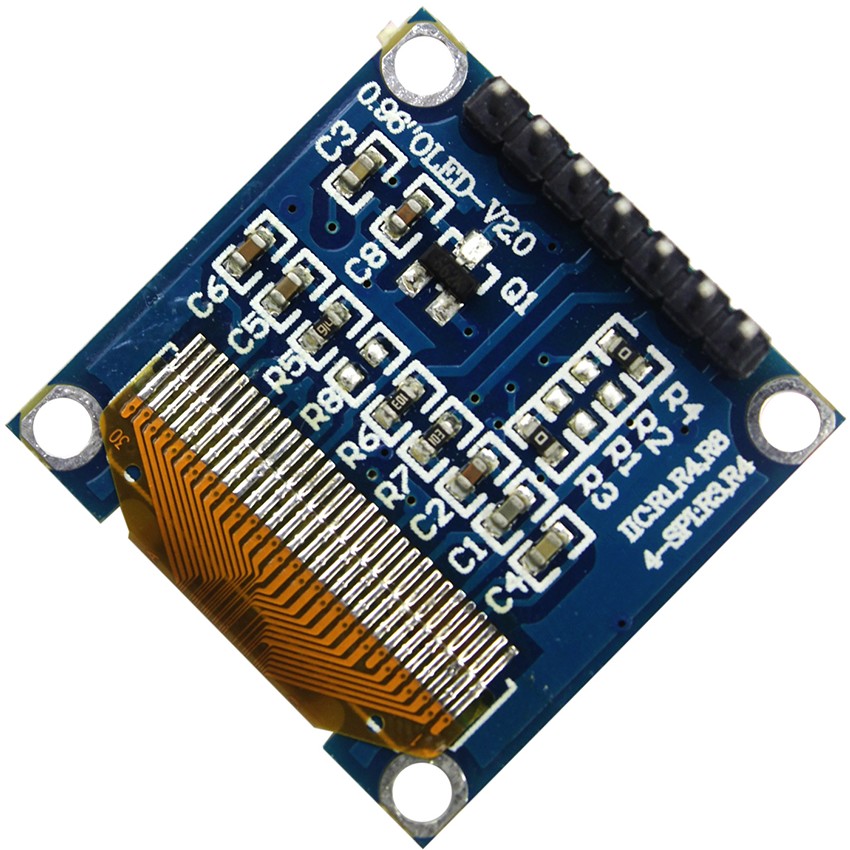
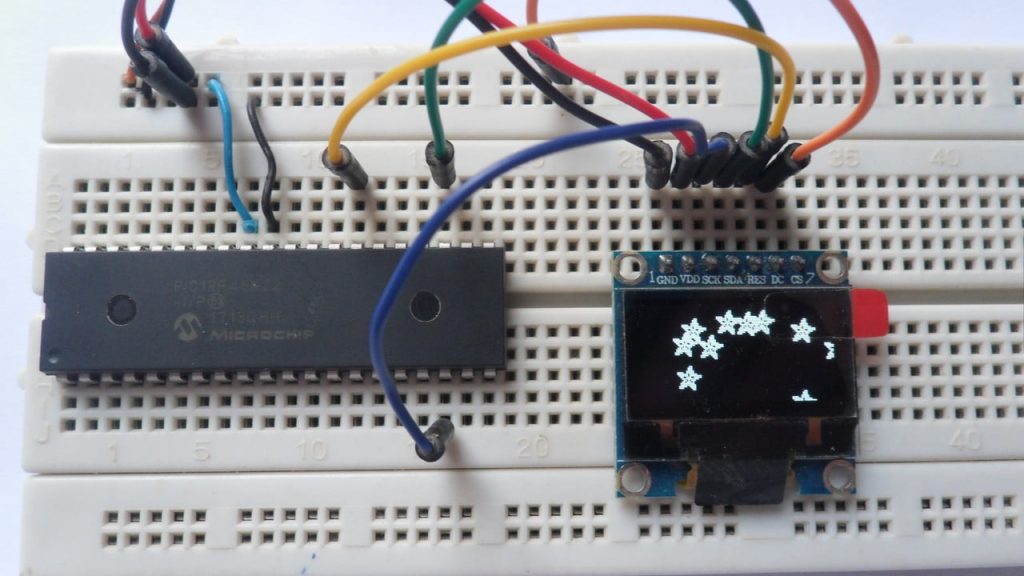
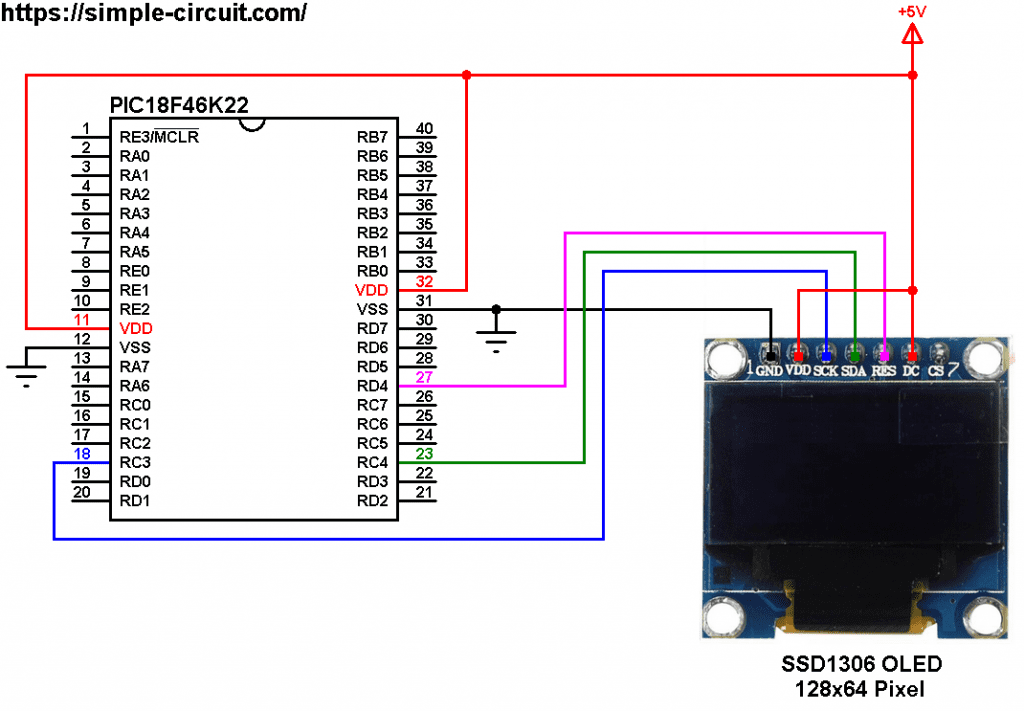
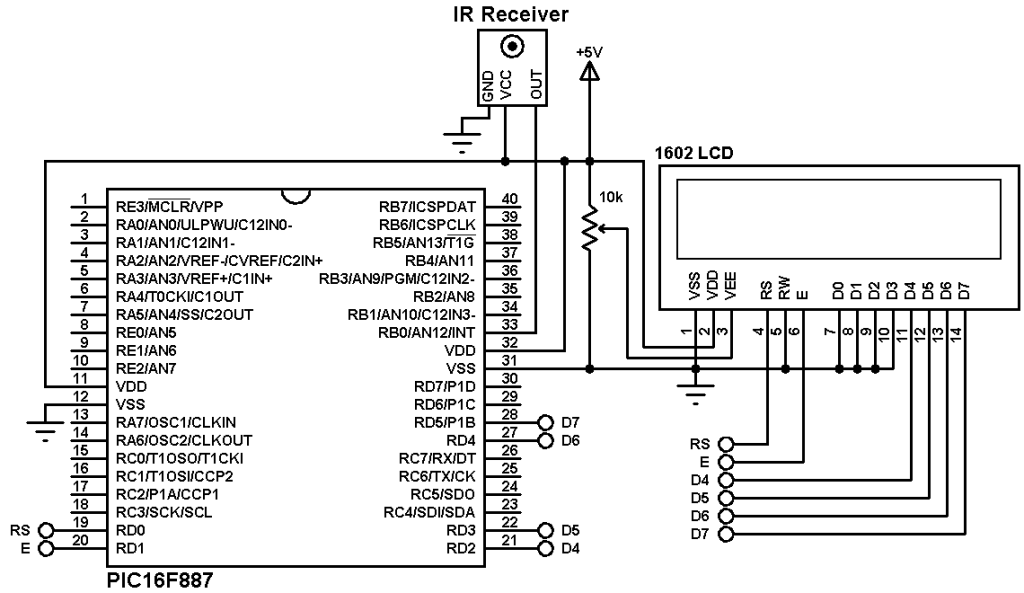
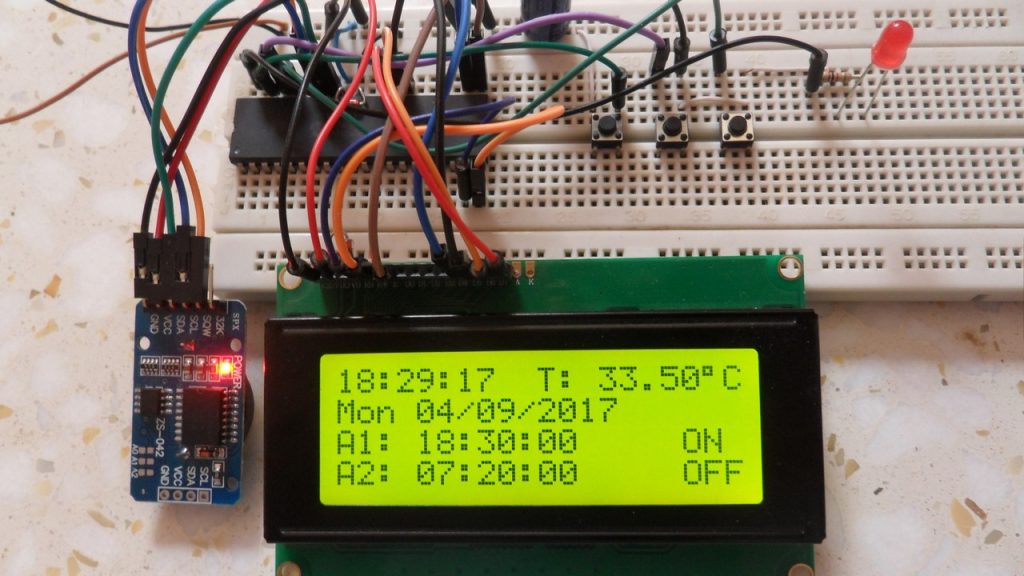
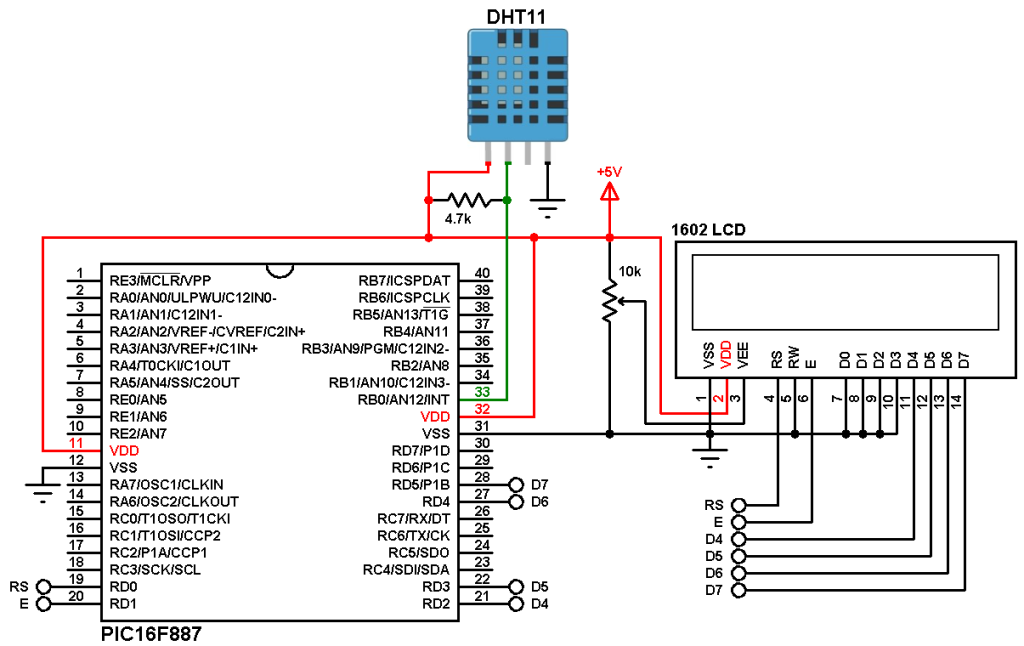
Not work, 1st of all is uncapable to include ssd1306oled.c
and after this, a lot of errors, wat a loss time omg
27 304 error: Can’t open include file “ssd1306oled.c” #include
61 304 error: Can’t open include file “ssd1306oled.c” #include 2 errors in preprocessor.
MikroC Pro v7.2.0
22 undeclared identifiers
Copied all files required, set all PIC18F46K22 parameters, does not compile.
Hi, I was trying to use your code to run a SSD1306 OLED with a PIC microcontroller, but after reviewing your code and trying to build it I can’t seem to find the functions for SSD1306_I2C_Start(), SSD1306_SSD_Write and SSD1306_I2C_Stop() used in SSD1306.c and also referenced in SS1306.h. Are we suppose to build these functions ourselves or could you please share a link to your code for the I2C codes? Thank you!
stdin.h is missing why ?
The File GFX_Library.c shows alot of errors. It does not work with MikroC., One day trying but not compiling at all.
Which microcontroller and mikroC version are you using?
I am getting similar errors in GFX_Library.c, with ‘undeclared identifier abs’ and others. I am using MikroC 6.6.2. Can you plz help what I am missing?